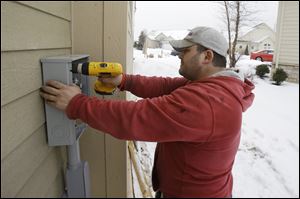
U.S. housing construction down 16% in January
2/19/2014
Paquale Cocca installs a new electrical box on a new home, in Pepper Pike, Ohio.
WASHINGTON — U.S. home construction fell in January for a second month but the weakness in both months reflected severe winter weather in many parts of the country. The expectation is that housing will deliver another year of solid gains, helped by an improving economy.
Builders started work at a seasonally adjusted annual rate of 880,000, down 16 percent from December, the Commerce Department reported today. In December, construction had fallen 4.8 percent. The declines in both months were blamed largely on the weather.
Applications for building permits fell in January for a third month, dropping 5.4 percent to a rate of 937,000.
For all of 2013, housing construction rose 17.7 percent to 976,000 units, the best showing since 2007. Analysts expect further gains this year as stronger job growth boosts demand.
For January, both single-family and apartment construction fell. Single-family building dropped 15.9 percent to a rate of 573,000 while apartment construction was down 16.3 percent to 307,000.
By region of the country, construction shot up 61.9 percent in the Northeast after two months of declines but was down in every other region of the country. Construction fell 67.7 percent in the Midwest to a record low of 50,000 units at an annual rate. The records go back to 1960. That big decline likely reflected the impact of severe weather in the Midwest in January. Construction was down 12.5 percent in the South and 17.4 percent in the West.
Economists said bad weather likely played a large role in the construction declines.
“Weather in December and January took its toll on housing and February may not see much improvement,” said Jennifer Lee, senior economist at BMO Capital Markets. She predicted a rebound in construction when spring arrives.
The expectation is that housing construction will rise for a fifth consecutive year, helped by further gains in employment and relatively low mortgage rates. Rates hit record lows in early 2013 but then they started rising as the Federal Reserve sent signals that it might begin to curtail its monthly bond purchases.
The Fed reduced those purchases in December and January, trimming them by $20 billion to $65 billion per month. Analysts expect the Fed will keep reducing the bond purchases in similar $10 billion moves at each meeting this year until eliminating the program in December.
U.S. homebuilders’ confidence in the housing market declined sharply in February, a drop that was blamed on the severe weather battering much of the nation.
Storms and cold weather dampened builders’ outlook for sales ahead of the spring home-selling season and could further slow the pace of home construction.
The National Association of Home Builders/Wells Fargo builder sentiment index released Tuesday slid to 46. That’s down from January’s reading of 56 and is the lowest level since May. Readings below 50 indicate that more builders view sales conditions as poor rather than good.
The overall index had been above 50 since June, reflecting a strengthening housing market. Some analysts suggested the February decline could be a one-month blip rather than a signal of a weaker environment. Typically, the spring season sets the pattern for residential hiring and construction in the ensuing months.
Sales of new homes jumped 16.4 percent last year to 428,000, the highest level in five years. Sales typically slow in November and December. But this winter’s onslaught of snowfall and freezing temperatures has exacerbated the seasonal slowdown.
The builder survey adds to reports showing that severe weather this winter has taken a toll on the economy. Auto sales fell 2.1 percent in January and posted their first year-over-year drop in sales since August 2010. Retail sales also tumbled last month after a smaller decline in December.
Though new homes represent only a fraction of the housing market, they have an outsize impact on the economy. Each home built creates an average of three jobs for a year and generates about $90,000 in tax revenue, according to data from the homebuilders association.